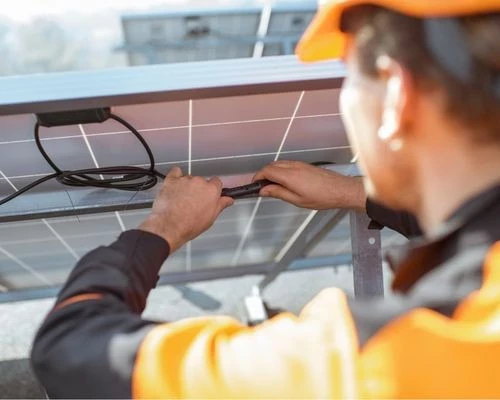Connected Workforce: What Oil and Gas Companies Need to Know About Private LTE
Add bookmark
After more than a year working to rollout a major “field” app, we learned from the app developer that we were their only customer attempting to use the app in the field. They were amazed that we were not doing the work on a desktop in the Control Room, printing the record, and taking that paper to the job site.
The struggles we had over that first year finally made sense.
They had sold us a field application that was not proven to work in the field.
This realization allowed us to shift gears and move onto the real issue. This was not the first vendor to sell us a “field” app that did not work where we wanted it to.
How do we push beyond these limitations that have plagued us for years? Why are O&G companies still doing so much work in the control rooms or kiosk locations? As an industry, why are we not doing more field work…in the field?
The Problem
For many companies in O&G, especially for refineries or downstream manufacturing, the problem has always been obvious: It’s the network.
We work in hazardous environments that are more like small cities built with mazes of steel beams and piping. Getting Wi-Fi signal into certain locations requires expensive installation of fiber and power extensions, all of which must go through certified contractors using specialized equipment and intrinsically safe installations.
When you have to replicate this fence to fence on hundreds of acres of metal, where line-of-sight is difficult, you end up spending millions of dollars on Wi-Fi infrastructure. That new infrastructure must then be supported with IT expertise, and life-cycled when appropriate.
Replicate this challenge across dozens of facilities and you have an extremely difficult task just trying to get an internet connection to your workforce.
To expand upon these difficulties, building a Wi-Fi network upon which mobile devices will work well (e.g., fast authentication, AP handoff, band steering, etc.) is a never-ending challenge of its own.
Even if you do build a solid Wi-Fi network, it is not guaranteed your fancy new iPads will work out-of-the-box.
How do you handle connecting a shared tablet to a secured corporate Wi-Fi network? Which MDM policies do you apply to enable Wi-Fi without user interaction? How do you update these policies over time without impacting users?
These are all challenges that many companies either do not want to deal with or they understand this difficult task and decide to punt until a future magic product solves their problems. Some have a little more cash and subscribe to public LTE providers instead, which creates new issues.
And what about using apps in offline mode?
It is 2022. Field apps require real-time connectivity. Modern apps require fast responses from cloud-based systems, and many field processes require collaboration to remote locations.
We need to accept that ‘offline mode’ should become a thing of the past. It was great for the first apps that allowed us to do static routine duties like operator rounds, but today we need to have real-time trends presented to us so that better decisions can be made faster. Do note that ‘offline mode’ itself is still a background feature that app developers should build in, as you will inevitably run into dead zones no matter where you are. That is good app design, but it should not be a crutch or hold you back from developing real-time app features.
The Solution
What has changed in the last several years to resolve these issues? Private LTE is available. You may also know it as CBRS, Band 48, n48, Advanced Wireless Networks (AWN) or other buzz words. For the purposes of this article, we will lump in 5G along with the concept of Private 4G LTE, but we will expand upon 5G later.
Let us first break down what Private LTE is.
There is a long history with the evolution of cellular networks over decades, but within the last 10 years we began to see a shift in how the U.S. government views use of this spectrum. The important piece is this:
“In 2015, the Commission adopted rules for shared commercial use of the 3550-3700 MHz band (3.5 GHz band). The Commission established the Citizens Broadband Radio Service (CBRS) and created a three-tiered access and authorization framework to accommodate shared federal and non-federal use of the band.”
Here are the referenced tiers. See the third tier, General Access:

Figure 1: Three-tiered CBRS Architecture.
Here are the FCC technical details of the band enabled:

Figure 2: The FCC’s Office of Economics and Analytics (OEA) and the Wireless Telecommunications Bureau auctioned Priority Access Licenses (PALs) in the 3550-3650 MHz range. Image Source: FCC.
To simplify, commercial entities such as those in oil & gas, are able to build their own cellular networks. We are no longer restricted to the public carriers such as Verizon or AT&T; we can get the benefits of using cellular networks but not be burdened with contracts or the high costs traditionally associated with them.
The Benefits
What are the benefits compared to traditional Wi-Fi or public LTE?
There are many, according to IoT distributor Novotech:
#1: Privacy
With Private LTE (versus public), data never leaves the enterprise customers’ network. This is especially important for highly regulated industries.
#2: Security
SIM-level device security ensures that devices have a unique identifier and are properly authenticated. This gives network administrators tight control over what devices are allowed on the network. Much simpler than dealing with complex Wi-Fi authentication processes.
#3: Flexibility
Private LTE networks can be customized to meet an organization’s unique application needs. This is important when you compare to app connectivity and dealing with handoff between Wi-Fi access points.
#4: Capacity
Private LTE networks can use either dedicated or shared spectrum. This puts the enterprise customer in control of bandwidth and infrastructure density, based on their individual needs.
#5: Quality of service (QoS)
Cellular technology provides a better quality of service than Wi-Fi and gives the customer control of how data traffic is prioritized, end to end.
#6: Latency
Deterministic latency - i.e. the ability to set a fixed length of time for the transfer of data - is available with Private LTE, thanks to full end-to-end control. Deterministic latency can be very important in factory settings where devices need to be tightly synchronized.
#7: Resiliency
With Private LTE, enterprise customers can deploy additional small cells for increased resiliency and uptime. They can also allow fallback to public LTE (if desired) using the same cellular device.
#8: Mobility
With Private LTE, mobility, that is, the hand-over between the individual small cells, is seamless and comparable to what users experience with public LTE. There’s no connection loss with Private LTE as there can be with Wi-Fi.
#9: Cost
Enterprise customers enjoy lower data transfer costs with Private LTE than with public LTE, an especially important consideration when there are high data volumes. In addition, while the cost of an individual high-powered small cell is higher than an enterprise-grade Wi-Fi access point, fewer small cells are needed to provide coverage over the same area.
#10: Simple to deploy
There are major third-party players in the Private LTE space that provide the A-to-Z services needed to setup these networks.
#11: Simple to support
No more dealing with Wi-Fi related connection issues. A SIM card and IMEI are locked together and assigned to a device. You’re done.
The Buildout
One of the most important benefits is how Private LTE is built out. Whereas Wi-Fi must be installed close by, locally section by section in your facility (where line-of-site is important), many LTE radios can be deployed around your facility and point inwards (depending on layout).
A facility that requires 500+ Wi-Fi access points can get the same or better network coverage with roughly 20 LTE radios (again, depending on layout). It is clear that Private LTE allows you to simplify your wireless network, decrease complexity in how devices connect and are supported, and ultimately provide a better quality of service for end users.
The thing to know is that there are many players in the Private LTE space, including the incumbents such as Verizon or T-Mobile. I am more partial to newer players that are less likely to drive up your costs or convert you to a subscription model. This includes Nokia, Kyndryl, Capgemini, Motorola, and a few VARs trying to figure out how they can fit into the space. Use your search engine of choice and you will find a growing field of companies selling Private LTE services; I imagine this will all consolidate in the next five years as they buy each other out.
Deployment
Once you do select your partner, there are basic steps that must take place:
Step 1: Site Surveys & Planning
Specialists will need to survey your facilities to determine which radios and configuration you need. After seeing this firsthand (with Wi-fi and LTE), I will say there does not appear to be an exact science to surveys. It is a mix of special mapping software, Google Earth, on-site testing using temporary radios and lifts, and ultimately making experienced decisions based on the information collected.

Image 3: Special mapping software and onsite surveys can help determine configuration and radios required.
Step 2: Installation
Private LTE is a corporate wireless network. It will need an internet connection, so that means it runs off your current backhaul. That also means there is a need for a firewall, switches, and other network related hardware.
It also requires cores to act as a packet gateway for the LTE traffic. How many cores you install, as well as off-site cores for redundancy, becomes an important discussion for your buildout. There are also many decisions needed for indoor radios for the office or BRMs (if desired).
Side note: There are also Wi-Fi gateways you can install to support your non-LTE devices on the same network. Unfortunately, I do not have any experience with these, but the concept seems simple enough.
Step 3: Device Setup & Management
Depending on the service you choose, you will be given a portal to login to where you can assign SIM cards and device IMEI numbers. This is pretty straightforward, but do note that this does not usually include Mobile Device Management (MDM) services. You will continue to use your existing MDM, but the portal can be given to Site IT to perform their own device setups.
Step 4: User Experience
From a user perspective, there is nothing to do as it relates to the network. Private LTE will be similar to their personal smartphones. It will just work after their device is provisioned.
Step 5: Support Contract
This is where these vendors will prove their worth and make their money. The yearly support contract should cover the A-to-Z support of the entire network, including on-site visits as needed.
Make sure you plan this appropriately.
The good thing is that if most of your radios can be installed around the facility rather than within, getting vendors in and out should not often include going into hazardous locations, which means site visits should be easier and faster to resolve issues.
Note: Do not wait for 5G
I have seen commentary from the industry about 5G and waiting for that to mature before doing any Private LTE, skipping over 4G. This is a mistake, and here is why:
You can now combine multiple channels within the band to bond them together. This gets you to what is called 4.9G - not quite 5G, but still lightning fast.
When we did a proof of concept on this, we had one LTE radio installed, and even while being 50 yards away behind piping, running a Teams meeting with video and screen sharing, we were getting 120+ Mb down. It is more than enough speed.
Working in hazardous environments, there are very few intrinsically safe mobile device options that support private 5G (Band n48). More are on their way, but you have access to existing devices that support LTE Band 48, which includes the Samsung X-Cover Pro or the iPhone 12. Don’t forget to choose your mobile platform wisely.
If you are thinking about IoT/OT, the vendors who provide these devices already support or are looking to support Private LTE today, not to mention the plethora of cards that can be attached to your everyday laptops or desktops that may run some of your equipment.
When you are ready for 5G, all you do is upgrade the necessary equipment. 5G can be deployed to be backwards compatible with your 4G devices, so no need to worry about buying devices now and then having to replace them right away.
Lastly, your competitors are already looking at this technology now. If you are not looking into Private LTE today, then you are already behind on this technology (in my opinion). Having a robust wireless network enables your digital twin initiatives from multiple angles, and it is an easy decision to make when thinking about where you can get the most value from new technology.
Conclusion
If you are not convinced that Private LTE will work for you, know that it is already being built in industries outside of O&G. Prisons are now installing Private LTE to provide service for inmates with tablets so they can contact family. Schools are installing them to decrease their technical footprint. Cities and municipalities are installing Private LTE to support homes. The list goes on and will continue to grow.
I am very excited to see what Private LTE will enable us to do in manufacturing and for the connected workforce in the field. The real interest for me is addressing the use cases that we could never do with Wi-Fi, as well as keeping an eye out for the unknown uses LTE will reveal.
Are you implementing Private LTE? Any lessons learned or stories you can share?
(First published on LinkedIn. Reprinted with permission of author.)
Interested in learning more about this topic?
Join us at The Connected Worker Summit on March 28-30, 2023 and network with over 150 of your industry peers at the Norris Conference Center in Houston, TX., and learn how to evaluate the existing gaps in your connected worker capability and identify the data-driven solutions that will drive continuous improvement across your operations. Download the agenda here.





























